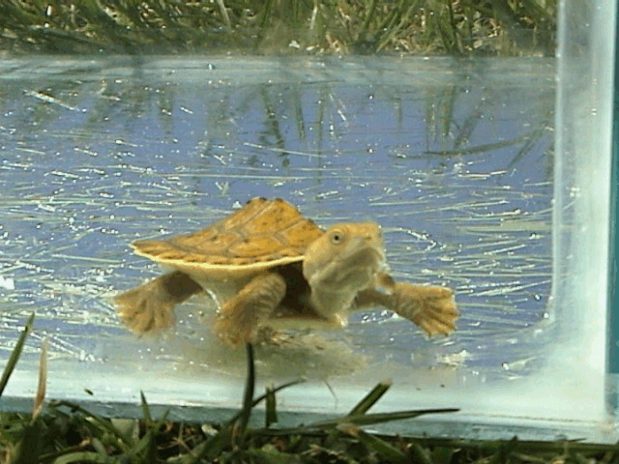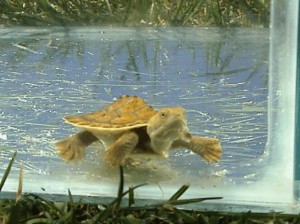

Turtles make terrific pets in either a home aquarium or even a pond. If well cared for a turtle could be your pet for as long as 30 years !!
General Information
The Species of turtle usually purchased in South Australia is the Murray short necked. However the long necked turtle is also available.
There are about 250 species of turtles in the world, of which 26 occur in Australia. Turtles are land and freshwater creatures.
Freshwater turtles are reptiles with clawed, webbed feet. They are around the size of a 20-cent piece when sold and can grow to the size of a large dinner plate when mature.
Sexes are difficult to determine. Both long and short necked turtles live almost exclusively in water for the first two to three years of their lives. They breathe air and need to be able to reach the surface easily.
The Tank
Young turtles are best kept in glass tanks or aquariums so observations can be made easily. Clean the tank regularly (ideally every second day) to prevent the water from fouling or algae and droppings to build up. A filter is recommended, though not essential.
Remove the turtle before filling the tank to allow the water to reach room temperature. Provide a calcium block, this reduces the acidity of the water and helps maintain a strong healthy shell. Place the tank near a window to allow light to penetrate in. Sunlight is necessary for proper bone formation and will also help the growth of any plants in the container.
However in summer ensure the container is not in direct sunlight or it will become too hot. Special fluorescent lights are available which also help promote plant growth.
Outdoor Housing
Outdoor pools must have a fence; otherwise the turtle may wander away or be attacked by other animals. A partial or full mesh wire roof may be desirable to keep predators way.
A pond measuring approx 2m long, 1m wide and 40cm deep, located in a summer shaded area with ramps would be ideal, as reptiles need external sources of heat. The pond should be cleaned regularly. It must have a layer of fine clean sand or clay because direct contact with hard surfaces such as concrete can harm the turtle.
Tank Setup
Water should be provided to a depth of at least 15cm and increased as the turtle grows. Rainwater is preferable.
A rack or land area is also necessary for the creature to rest on. Water temperature should not exceed 28 degrees Celsius but must not be too cold either.
An incandescent lamp suspended over the container, or a tank heater with thermostat will prevent this. Ideally the tank should be maintained at 22 degrees Celsius.)
Hibernation
During winter the turtle outside may hibernate, either in the pool or outside it provided there is enough cover, such as dead leaves or leafy bushes to hide. The turtle should be left alone during this period and not handled. It will be sluggish and not accept food.
Turtles housed indoors will not hibernate if the water temperature is kept at a moderate constant temperature.
This will cause them to grow quicker than if hibernation occurs. When the room temp and the water temp are allowed to fall in winter, the turtle will become lethargic and then hibernate.
When this occurs they should not be disturbed or fed. Hibernation can be disastrous for young turtles because they do not have enough body fat to supply their needs over winter. It is far safer to keep the water temp at an optimal level using a heater so they remain active for at least the first year or so.
Being reptiles, freshwater turtles periodically shed their skin (sloughing) in order to grow. This is not undertaken at any fixed time of year and it is not cause for concern.
Feeding
Either turtles will not feed, or digestion will not occur if the water temp is too cold. Feeding should always be in the water. There are commercial frozen turtle foods, which are generally very suitable. At Aquarium Fish Paradise we sell 4 different types of frozen food for your turtle.
Baby turtles are used to being fed live food, especially insects. If your baby turtle is reluctant to eat, try feeding these – however make sure they have not been contaminated with fly spray. Mosquito wrigglers are ideal, especially for the first few weeks.
Turtles should have access to plant material, either water weeds or a little lettuce daily is suitable.
Feed baby turtles twice a day during their first summer and then decrease to once a day.
Larger turtles, over two years can be fed three times a week during summer and once or twice a fortnight during winter. If held in cool conditions, some will not feed at all in winter.
Do not leave uneaten food in the tank. It fouls the water. Some people prefer to feed turtles in a bucket of water so the tank stays cleaner. If you do this, place the turtle in the bucket with food for about 20 minutes then return it to the tank.
Common Problems
Poorly formed, soft distorted shells and bones can result from not enough sunlight or from feeding only raw meat. Add calcium to the food to prevent this or better still a balanced diet.
If the turtle is handled roughly, or the water is too warm, cracked shells and skin sores may appear.
Fungus is a common problem, often caused by poor water quality and exacerbated stress. As a preventative, some people add Myxazin, a broad spectrum medication to the tank on a regular basis at the rate of 1 drop/5 litres. If fungus is detected, take the turtle out of the water and add 2gms/1 litre of aquarium salt to the tank. Paint the
fungus with Betadine and only put the turtle back in the tank for two hours a day to feed. Alternatively paint the fungus with Myxazine and place the turtle in the tank when dry.
If a young turtle spends a significant amount of time out of the water, it is likely that a fungal infection is developing.
Respiratory infections may occur especially if husbandry standards slip a little or if the temperature changes suddenly. Often the first sign is that the turtle is blowing bubbles, if you observe this, call us for some antibiotics or see a vet.
Holiday Care
 Like any animal, turtles should not be left unattended when you go on holidays. Ensure that you make arrangements
Like any animal, turtles should not be left unattended when you go on holidays. Ensure that you make arrangements
for someone to care for them until you return.
– Written mostly by
John and Judy Bannear
Chelodina Longicolls (long necked turtle)
Emydura Macquari (short necked turtle)

Leave a Reply
You must be logged in to post a comment.